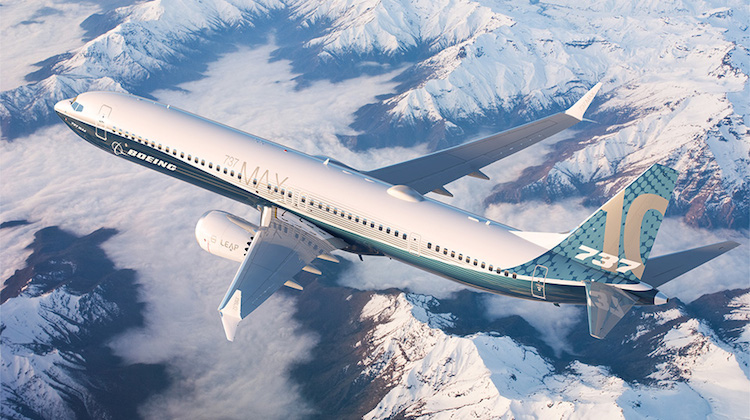
Boeing has launched the 737 MAX 10 at the 2017 Paris Airshow with orders and commitments for 240 of the type from 10 customers.
While the company has been publicly touting the proposed aircraft since as early as March 2017, the first day of the Paris Airshow marked the official introduction of what is the fifth and largest variant of the 737 MAX program.
The aircraft is configured to fly 3,215nm with 230 passengers in a single-class layout, Boeing said in a statement on Monday (European time). Entry into service was expected to occur in 2020.
Announced customers on the day the 737 MAX 10 was launched included BOC Aviation, GE Capital, CDB Aviation, TUI Group, Tibet Financial Leasing, SpiceJet and Lion Air Group.
Some of the orders were also detailed on Boeing Commercial Airplanes’ Twitter page.
Thanks to CDB Aviation for their commitment to the 737 MAX and 787 Dreamliner. https://t.co/RblORBXdAd https://t.co/SZmhxntqjL #PAS17 pic.twitter.com/I0WQm9fOlO
— Boeing Airplanes (@BoeingAirplanes) June 19, 2017
Thanks to BOC Aviation for committing for 10 737 MAX 10 airplanes! https://t.co/SZmhxntqjL #ThinkMAX #737MAX #PAS17 pic.twitter.com/S0N02YVKjY
— Boeing Airplanes (@BoeingAirplanes) June 19, 2017
ALAFCO commits to buying 20 737 MAX 8s. https://t.co/MNUgUVNr2y #PAS17 #ThinkMAX #737MAX pic.twitter.com/hPaIXczPKB
— Boeing Airplanes (@BoeingAirplanes) June 19, 2017
Boeing said more customers would be announced during the Paris Airshow.
“The 737 MAX 10 extends the competitive advantage of the 737 MAX family and we’re honored that so many customers across the world have embraced the outstanding value it will bring to their fleets,” Boeing Commercial Airplanes president and chief executive Kevin McAllister said in a statement.
“Airlines wanted a larger, better option in the large single-aisle segment with the operating advantages of the 737 MAX family. Adding the 737 MAX 10 gives our customers the most flexibility in the market, providing their fleets the range capability, fuel efficiency and unsurpassed reliability that the 737 MAX family is widely known for.”
The 737 MAX 10 is the fifth variant of the MAX program, which was first launched in August 2011.
The MAX family of aircraft features a new flightdeck, fly-by-wire spoilers and new technology winglets compared with the current model 737 NG. It is powered by CFM International LEAP 1B 176cm fan diameter engines, compared with the CFM56 155cm fan diameter on the NG.
To accommodate the larger diameter engine, the MAX incorporates a taller nose wheel landing gear leg, while the engine nacelles’ trailing edges feature noise-reducing chevron shaping, as also seen on the 787.
Boeing said other changes of the the 737 MAX 10 included a levered main landing gear, a variable exit limit rating mid-exit door, a lighter flat aft pressure bulkhead and a modified wing for low speed drag reduction.
Industry estimates suggest Airbus’ A321neo was outselling the 737 MAX 9 by a factor of five to one, prompting Boeing to respond with the MAX 10.
The other variants include the MAX 8, which at 3,515nm range with 162 passengers in a two-class configuration Boeing describes as the “heart of the market”, was certified in March. First delivery to launch operator Batik Air Malaysia, part of Indonesia-based Lion Air group’s portfolio of carriers, was in May.
The larger MAX 9 has been designed with a maximum range of 3,515nm for up to 220 passengers in a single-class or 178 passengers in a two-class configuration.
The company is also building the 200-seat MAX 200, which uses the same fuselage as the MAX 8 but trades reduced range for more seats. Ryanair is the launch customer.
The smallest variant, the MAX 7, has been designed to carry 138 passengers in a two-class layout 3,825nm. Assembly of the first aircraft is expected in the final quarter of calendar 2017, with first flight in the first quarter of calendar 2018.
In this part of the world, Virgin Australia has ordered 40 737 MAX aircraft. The airline recently deferred first delivery to the “final quarter of the 2019 calendar year”, from 2018 previously.
Boeing’s other two 737 MAX customers in Oceania are Air Niugini, which put pen to paper in February 2016 for four MAX aircraft arriving from 2020, and Fiji Airways, which has five 737 MAX 8s slated for delivery from 2018.
Meanwhile, Qantas is expected to run a competition between the 737 MAX and A320neo at some future point for the replacement of its existing 737-800 fleet.
In April, Boeing 737 MAX chief project engineer and deputy program manager Michael Teal said the MAX 10 would be a 1.68m stretch of the MAX 9, with 1.17m forward of the wing and the remaining aft of the wing.
As a result, Boeing engineers were working on a larger landing gear to accommodate the additional length of the aircraft.
“We just need a little more extension of that gear to enable the same rotation margin on takeoff as well as the landing performance from a contact margin,” Teal explained to reporters during a conference call.
“We’ve looked at several different design parameters. We are still in what I’ll call that design development.
“I’ve seen several of our concepts that we are now putting into prototype testing. It’s looking really good and I don’t feel we’re going to have any real issues with it. It’s just getting that final design done.”
The aircraft was expected to reach firm configuration at the end of 2017, with first delivery targeted for 2020.
Boeing published a video introducing the 737 MAX 10 on its website.











